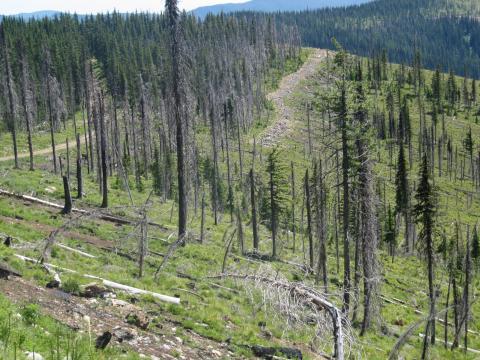Diameter growth was examined on small diameter whitebark pine 20 years after silvicultural treatments were applied.
Whitebark pine (Pinus albicaulis Engelm.) forests play a prominent role throughout high-elevation ecosystems in the northern Rocky Mountains, however, they are vanishing from the high mountain landscape due to three factors: exotic white pine blister rust invasions, mountain pine beetle outbreaks, and successional replacement by more shade-tolerant tree species historically controlled by wildfire. Land managers are attempting to restore whitebark pine communities using prescribed fire and silvicultural cuttings but are unsure if these techniques are effective. The objective of this study was to determine how whitebark pine regeneration responds to selective thinning and prescribed burn treatments. We studied changes in diameter growth after restoration treatments using ring width measurements obtained from 93 trees at four sites in Montana and Idaho that were treated in the late 1990s 4 sites were located with different combinations of treatments (control, thin only, burn only, thin and burn) through Idaho and Montana. Plots were located within the treatment units and then one to four saplings were selected within these plots and cross-sectional samples extracted (increment cores or stem cookies) from them. Cores were sanded and measured using standardized dendrochronological methods, and basal area increment (BAI) growth calculated using the dplR package in R. The BAI measurements for ten years prior and ten years post treatment were used to calculate growth ratios (GRs), and growth post-treatment to growth pre-treatment were related. GRs greater than 1.0 translated to an increase in growth after treatment, and GRs less than one correspond to a decrease in growth. An ANCOVA was used to explore factors that might influence radial growth response and two-sample t-tests were also conducted to evaluate differences between the average GRs of trees in the control areas and of the trees in the treated areas.
- The average annual radial growth rates of the trees in treated areas were greater than those of trees in control areas.
- There were significant increases in the growth ratio (180%) in the two sites that were both thinned and later burned.
- Younger regeneration showed more response to the treatments than older regeneration.
- All sites showed high variability in post-treatment growth rates across individual trees, with greater variability for trees in treated areas than in trees from the control areas.
- Results suggest that whitebark pine regeneration can respond to thin and burn release treatments and that managers may see positive results in areas that are treated similarly
For geographical information on this project and how it fits with other Fire Lab Whitebark Pine research, visit the Whitebark Pine Story Map.
